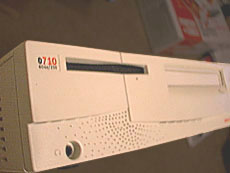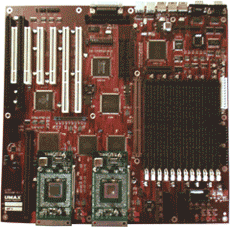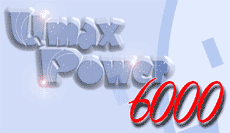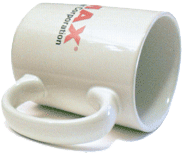The SuperMac that almost was... The 200MHz 604e J710. ...and one that would never be.  The Basecamp CHRP logic board (above), loaded up with dual ZIF-socketed 200MHz 604e's, and one proposed name & graphic for the system it might have become (below). 
|
The air supply had been cut off. New machines would never see public release. Basecamp flirted with the Summit but had nowhere to go but down. Mac OS 8 was the last version that would be licensed, and then only by Umax -- who, as the last Mac clone maker left standing, faced an even harder time convincing the computer-buying public that a Mac clone was still a viable alternative (to anything). A drastic retrenching was in order if UCC were to survive in any form. IPO plans were scrapped. Hiring was frozen. Open positions were cancelled. Two locations were condensed into one. Margarita Fridays were cut back to once a month. No one snickered at Jordan's beat-up old Porsche anymore -- it ran, and it was paid for. And the future was in PC's, which no one at UCC was especially excited about.
Sociologists have found that a culture can usually rebound from one major blow as long as a second does not follow too close behind. UCC's second blow, even more demoralizing than the first, was the departure of its leader, Peter Mehring. The baton was passed to Russell Shikami, who faced the unenviable double-challenge of rallying the Mac-faithful troops to the PC cause while also making sense of Umax' ever-changing intentions for its new PC group. There was some light at the end of the tunnel, but there was also the feeling that the tunnel was constricting.
Engineering had already begun development on "Herbert" and "Amber," two cool (but not too cool) Intel-based systems. Amber was a nice, dual-processor-capable system with built-in, Adaptec-based, dual-channel UltraWide SCSI and full RAID support right on the logic board. Umax Computer Corporation would essentially morph into Umax Labs, providing sustaining engineering support for the SuperMac line but really driving all resources into the PC side of things. How this would balance with Umax Technologies' existing PC line was unclear.
On May 27th, 1998, it was clarified. Umax Labs would not be formed. All employees except the Quality & Services group of UCC were laid off. That group would be retained for all sustaining engineering, field service, and escalation management of the SuperMac products. A few employees vanished the same afternoon. Most others left gradually over the next few months, in large part to Philips' new Flat Panel Displays division. Other landing places included Apple, Transmeta, Echelon, Centigram, SGI, Digital Origin, Microsoft, and Outback Steakhouse (seriously -- many of the Australian voiceovers on Outback's TV and radio commercials are done by the man who created most of UCC's original graphics). SuperMac office systems, along with the ill-fated Umax/SuperMac monitors, were sold to departing employees for next to nothing -- including the J710, which accounts for the few dozen in use today.
The next seven months were very strange for those who remained. On the plus side, everyone was free to take on whatever job role he or she wanted, we all got window views on the fourth floor, disk driver issues in Mac OS 8.5's installer added some much-needed excitement in October, and the question of our future had at least been answered. Titles became a bit inflated, such as "Executive Senior VP of My Cubicle." On the downside, there were close to a hundred ghosts in those halls, the SuperMac dream had died, and we knew we'd be lucky to have jobs by the end of the year. The promise of taking over UTI's PC efforts fell through (a blessing in disguise, really), and the few remaining employees were leaving at a rate of about one per month. Only four remained when we were finally absorbed into the larger UTI organization in Fremont in December. I quit the next day. The last three were let go a few days after Christmas. Happy Holidays!

Looking back almost five years later, the Mac clone business produced some great products, provided work for a terrific bunch of people for a few years, helped to further Mac technology in a variety of ways, and was a business disaster. Rather than draw from PC/Windows sales and grow the Mac OS market share, the business really only cannibalized Apple sales -- even while Mac OS market share at large continued to fall. Mac clone presence at PC-oriented trade shows and publications was minimal to non-existent. The few workstation-class advancements incorporated into the clones impressed only the Mac faithful and were rapidly outstripped by the G3 on every level. A few corporate bodies gave the Mac OS a second look once Apple was no longer the single-source systems vendor, but this led to appreciable volume only for Motorola's StarMax line. Despite some great name recognition, the SuperMac name never earned a penny of profit for Umax. On the contrary, the entire venture was reported to have lost about $36-million. Approximately 100,000 SuperMac computers were built and sold before the line met its premature demise.
The SuperMac systems developed a great reputation for flexibility and expandability which survives today. Some die-hard users even managed to get early versions of Mac OS X to run on them. There are a number of S900s and J710s in my family today, running reliably along and showing no signs of stopping. And even the Amber logic board, which never made it past the early developmental stage, makes for a half-decent PC today. The original StormSurge 150 design team should be proud.
Apple is far stronger today than in 1998, and for the Macintosh community, that's all that matters. But shortly after Mac cloning ended, John Sculley conceded that Apple should have licensed the Mac OS during his reign years earlier. Early enough, and it might have made a positive difference. With rumors of Apple on Intel and some sort of alliance with Sun churning again, it may yet.
It couldn't be too much more weird than what's already happened.
Kennedy Brandt
August 4, 2002
updated August 10, 2003
